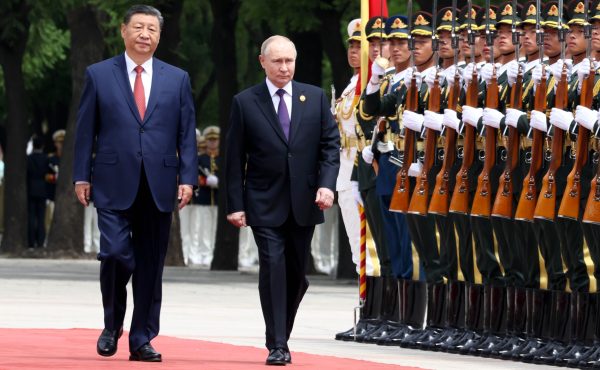The hope that Beijing would distance itself, however minimally, from Moscow has finally been extinguished. Europe needs to adjust its approach accordingly.
Written by Maximilian Mayer, professor of International Relations and the Global Politics of Technology at the University of Bonn, Germany • Emilian Kavalski, NAWA Chair professor at the Jagiellonian University in Krakow. Poland.
That Russian President Vladimir Putin is preparing for a long war not just in Ukraine, but against Western democracies more broadly, should hardly be news, even if many in Europe and North America refuse to acknowledge this fact. At least since the 2008 Russian intervention in the conflict in Georgia, Putin has condoned a series of both hot and hybrid warfare campaigns to weaken the democratic fabric of countries in Russia’s vicinity and further afield. It was recently revealed that on the eve of the full-scale invasion of Ukraine in February 2022, Russia launched a spacecraft to test nuclear anti-satellite weapons, further evidence of Moscow’s plan for long-term confrontation with the West, beyond what it considers its “near abroad.”
Yet, that China is willing to fully back Putin’s effort to threaten and undermine liberal democratic states is certainly a newsflash. Ever since Russia’s full-scale attack on Ukraine in February 2022, Beijing has been treading carefully to avoid perceptions that it is overtly supporting Moscow and has been claiming to occupy a neutral position – even if China has been leaning toward Russia’s side.
The reason seems obvious. Despite increasing tariffs, anti-subsidy probes, and European derisking strategies, both China’s export-oriented economy and the bottom line of most Chinese companies are still tied to trade with Western firms as part of global supply chains. It was therefore common sense to assume that Beijing would move cautiously to avoid jeopardizing its economic security in the context of an increasingly unpredictable domestic market and escalating economic tensions with the United States.
However, either such assessments have been misplaced or China’s wariness appears to have evaporated. The spark of hope that Beijing would distance itself, however minimally, from Moscow has been finally extinguished.
The most recent joint diplomatic statement by Putin and Chinese President Xi Jinping suggests that China and Russia, although not formally allies, have formed a bloc-like alliance that is geared toward undermining security in Europe. The joint statement issued after last month’s meeting between Putin and Xi in Beijing explicitly stated that both partners “believe that all nuclear weapons states… should refrain from infringing upon each other’s vital interests through the expansion of military alliances and coalitions, as well as the establishment of military bases in close proximity to the borders of the other nuclear weapons states.” In other words, this passage spells out what China understands by insisting upon the “legitimate security interests and concerns of all countries.”
The comprehensive clarity of the lengthy statement goes beyond the mere reiteration of Putin’s talking points. It boils down to an explicit statement of intent – namely, Beijing’s intent to work with Moscow in undermining Europe’s security at a moment when the EU has communicated that Russia’s war against Ukraine is an “existential” threat to Europe. China is not only ready to challenge NATO’s guarantee for the security of states in Eastern Europe, but also the increasing activities of the Western European members of the alliance on NATO’s eastern flank in support of Ukraine.
It is significant that Xi’s meeting with Putin came on the heels of the Chinese leader’s visit to Serbia and Hungary. This trip was indicative of China’s strategic direction. Xi visited Serbia on the 25th anniversary of NATO’s bombing of the Chinese embassy in Belgrade, something that he stated the Chinese people will “never forget.” In Hungary, Xi signed a new security pact, which would allow Chinese law enforcement to conduct patrols in the country and install surveillance equipment. However, as revelations of a number of secret annexes to the pact suggest, Chinese police officers may avail themselves of the Schengen travel arrangements and visit other European countries to conduct “secret missions,” including arresting dissidents and bringing them back to Hungary before taking them to China.
The joint statement between Putin and Xi is quite unambiguous that the strategic infrastructure of Western “military alliances” is perceived as a threat to both China and Russia. The call for the establishment of loosely defined buffer zones in the peripheries of nuclear powers is surprising, in that it goes against China’s self-avowed principle of non-interference in the domestic affairs of states and contradicts the habitually repeated Chinese warnings against “Cold War mentality.” More than that, this statement also indicates that Beijing and Moscow are throwing under the bus the national sovereignty of the smaller states in between. Instead, might makes right – small states will be subject to the whims of great powers and their spheres of influence.
It is not far-fetched to interpret the Sino-Russian statement as Beijing’s legitimization of Moscow’s brinkmanship in Europe, short of using nuclear weapons. It is no coincidence, that immediately after the Putin-Xi meeting, Russia’s defense ministry posted a draft proposal for the revision of the country’s maritime borders in the eastern Baltic Sea. A few days later, in another test of Western resolve, Russian border guards removed dozens of light buoys demarcating the Estonia-Russia border along the Narva River.
While the full implications of the joint statement will become more obvious in the coming weeks and months, several takeaways help to shed light on the contours of Sino-European relations during the new Cold War.
First, in the midst of mutual retaliatory rhetoric about trade restrictions, this is China’s loudest signal yet that its strategic outlook is officially framed from the perspective of a new Cold War with the West. While Russia might be playing a “junior partner” in the alliance, it is Beijing that is following Moscow’s lead into uncompromising strategic antagonism with the West and especially the European Union. This does not mean that there is ample trust between Russia and China, but the logic of a bloc confrontation is underpinning Beijing’s commitment to cooperate with Moscow ever more closely. The symbolic gesture of Putin’s official visit to the Harbin Institute of Technology, which could indicate more Russian access to Chinese defense technology, has not been lost on European observers.
In the new Cold War, Russia is more important to the Chinese leadership than Europe. The relevance of bilateral relations goes beyond the reality of growing economic complementarities and trade figures between the two Eurasian giants. The joint statement is the strongest indication yet that China is not averse to forming a military alliance with Russia. The document clearly spells out that bloc confrontation is the new game in town, despite Chinese reassurances about further economic opening and a charm offensive to European businesses. In France, Xi only offered a vague answer to European Commission President Ursula von der Leyen’s plea to limit the deliveries of dual use goods to Russia. Beijing, it seems, has already priced in the inadvertent “loss of Europe” as the cost of its partnership with Moscow.
In the new Cold War, Eastern Europe and the Indo-Pacific are part of a united Eurasian strategic theater. Geographically, just like the 20th-century Cold War, the new one reflects the expansive logic of malleable buffer zones. The fault lines of the Sino-Russian confrontation with the West follow a north-south gradient across the landmass of Eastern Europe and a southwest-northeast gradient from the South China Sea to the Korean Peninsula. Although China has officially always rejected the connections between the Ukraine and Taiwan crises, this linkage is now more conspicuous than ever before. While such a scenario will probably be hard to swallow for Europe, it is becoming hard to ignore that China will be part of any future European security order. Europe, given its overreliance on U.S. security provision, has less wiggle room and no choice but to get closer with the United States.
Europe’s security requires significant realignment of its strategic focus. Faced with large-scale crises such as migration, economic inequality, climate change, and populism, European policymakers struggle to formulate a coherent strategy. The prospect of a strengthened Russian economy and sustained armed conflict in Ukraine presents new challenges that call on Europe to enhance its military capabilities and seriously prepare for a range of contingencies. It appears that both Moscow and Beijing are ready for the turbulence of the new Cold War. European leaders are still to fully grasp its reality.
The joint China-Russia statement marks a world political closure. Bloc confrontation is a new reality, although the rest of the world tries as hard as possible to avoid taking sides. In the absence of significant hard power, Europe does not have the luxury of contemplating a neutral position. Economic interdependencies with China become more problematic. Trade and security policies are now not only seen as intimately entangled, but also point in increasingly contradictory directions. Current attempts at decoupling between the economies of China and the West will thus likely intensify, rendering the management of conflicts increasingly difficult.
As the West might fracture under the pressure of multiple crises and see its resolve buckle through the constant disinformation campaigns of Russia and China, it is difficult to anticipate what trajectories the confrontation will take. In this precarious new Cold War scenario, Europe has to consider both the attitude of a new U.S. administration and Chinese views on such contingencies.
For instance, what would leaders in Beijing view a possible “win” for China in Ukraine? Some Chinese experts are betting on a “Korean” type solution for the conflict. This would include a buffer zone between Russia and NATO in Europe and a demilitarized zone partitioning Ukrainian territory. As a result, Russia would be in a stronger position to seek domination over Eastern Europe’s states as well as pressure NATO to roll back its membership to pre-1994 levels.
The most pressing issue along the two geographical fault lines in the coming years is keeping the new Cold War “cold” and preventing it from becoming a full-blown global hot war. Overall, there are reasons not to be overly pessimistic. The logic of nuclear deterrence is functional. China and the United States are ill-prepared to fight a war, and the risk of skirmishes in the South China Sea makes both sides more restrained. However, escalatory trends remain and flash points are multiplying, while mechanisms to avoid escalation such as monitoring, mutual surveillance programs, and regular military-to-military talks are few and far between.
For Europe, to maintain a sense of pragmatic optimisms is more difficult. China and the United States can rely on historical precedent to ensure their coexistence as superpowers and create, for example, their own version of SALT. Europe, however, does not possess historical templates and its tripartite approach to China – as partner, competitor, and rival – is woefully outdated because it lacks a security angle altogether.
Europe needs to quickly come to grips with a China that both openly supports Russia’s imperial war and works with Moscow to end NATO’s presence in Eastern Europe.
deleted by creator
Everything you’re writing is 1:1 Russian state misinformation, completely identical to lies spread by the Russian government in order to justify their imperialistic expansion.
removed by mod
removed by mod



